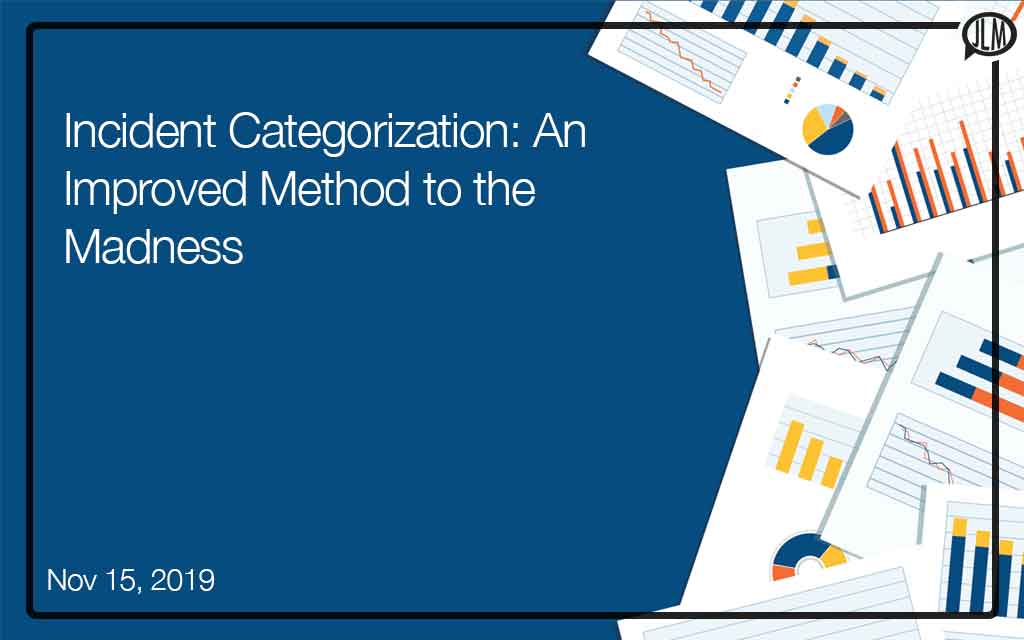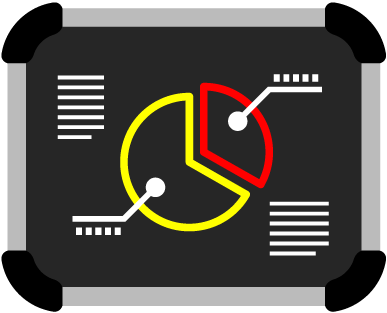![]()
Incident categorization is a challenge for IT organizations. Whether it is due to culture, politics, complexity, or an inability to agree — every organization at some point finds that the categorization of incidents is ineffective, out-of-control, or difficult to maintain. Why does it cause so much of a challenge? There is no one right way to create a categorization. There isn’t a template available that you can use. Every organization is different. The products and services are different. The service levels are different. The customers are different, and the required information to track is different. Even the reports differ. These distinguishing factors impact how incidents are tracked and monitored. There is no master categorization theme to use because it is up to your organization to define what works for your environment.
What is Categorization?
Categorization is an essential activity in both incident and problem management. Categorization is the process of arranging incidents and problems into classes or categories. The main objective is to understand what type of incident has occurred. Over time, if incidents are categorized similarly, the data is then used to identify trends and focus efforts on improving proactively. If the data is flawed due to poor categorization, then it makes it incredibly challenging to know what improvements are needed and how to prioritize improvements.
Prioritization is also an important activity that identifies the importance of an issue related to business impact and urgency. In most environments, categorization will drive what is set for a priority. For example, a critical business application that is used by a vital business function may require faster response and resolution timeframes when setting the priority of an incident.
Two Examples of Categorization
Categorization is not just used in the management of transactional work within an IT organization. We use classification to arrange a vast array of datasets. Two examples are the Dewey Decimal System and a recipe box. Let’s examine both in more detail.
The Dewey Decimal System
In most libraries around the world, the Dewey decimal system is used to classify or categorize books. Essentially the goal is to organize knowledge into ten main classes. Each main class is then further subdivided into ten divisions. Each division is then further divided into ten sections. Ultimately, the categorization system contains ten main classes, 100 divisions, and 1000 sections. The Dewey Decimal System identifies the correct location to store and retrieve a book within the library’s bookshelves. Additionally, books of a similar genre are stored on the same shelf and related works on shelves nearby.
A Recipe Box
A recipe box is also an example of a categorization scheme. However, with this categorization, there is no established standard to follow. For instance, you could store the recipes by food type (appetizers, beverages, bread, breakfast, cakes, candies….) or to make it easier to find a recipe based upon the food you have in your cupboard you could store them based upon main ingredient (apples, bananas, beans, beef, berries…..). Other categorizations could include ethnic identity (Asian, Chinese, European, French….), special occasion, or by unique classifications (6 ingredients or less, bread machine, casseroles, diabetic…). The options provide an extensive array of possibilities, but it also is an example similar to what happens in organizations with incident classification. Without standardization – recipes can be stored in more than one category and may make it difficult to find.
Why is Categorization Important?
Linking of Service Management Information
When incidents, problems, known errors, events, workarounds, and changes share a common or similar categorization scheme, it is much easier to link the related records. For example, a service owner can run a report and find all incidents, problems, events, known errors, workarounds, and changes related to a service.
Improved Root Cause Elimination
Trend analysis based upon categorization can help to identify faulty components, repetitive errors, and assist with more accurate root cause analysis. Historical information related to services is only helpful when trends can be identified. If a problem or incident can be entered into the service management system in more than one way – trends can be missed or under-reported.
Improved Knowledge Searches
When an incident can only be categorized in one way, the search against previous knowledge is more effective. The analyst searches for knowledge in the form of incidents, problems, or known errors within the same categorization. The categorization provides the context for searching for related knowledge and narrows down the data to a much more manageable subset. If knowledge is not present, the categorization provides the structure to begin gathering the necessary information to diagnose and categorize the new knowledge.
Improved Process Efficiency
The activity of categorizing the incident speeds up the incident management process and creates greater efficiency within the process flow. If the issue cannot be solved, the categorization determines the appropriate incident escalation group. When the escalation group is tied to the categorization, the organization can eliminate errors in escalation and improve the efficiency of the incident management process. Additionally, categorization is often related to service levels by defining a default priority for each category/type/item based upon business requirements.
Service Improvements
Finally, another benefit to useful categorization is the ability to produce meaningful reports that help the organization to take a more proactive approach to manage services. The available information is used by the service manager along with continual service improvement to make informed decisions on how to improve the overall quality and delivery of services and possible ways to innovate services in meaningful ways for the business.
Why is it so Challenging?
Organizations allocate resources to different functional units that require specific skills and experience to manage the infrastructure effectively and manage services for improvements in business outcomes. However, the functional units often have very different perspectives on what represents an appropriate structure. Typically one group wins out on the discussion, and the categorization is established that will be used by all functional units. Another contributing factor to the difficulty of developing a single structure that works for the entire organization is that the infrastructure is complex, and it is difficult to determine a structure that works.
Often there are pollical pressures to make changes to the structure. For example, if a product or service is not listed explicitly in the categorization structure, it can be viewed as not being important enough to the organization. When this occurs, pressure is often used to get a product added to the categorization so that it gains visibility. Also, as the organization goes through change, the categorization grows organically over time as products are added and released from the environment. The organic growth often results in a fragmented structure to the categorization. The fragmentation is worse in environments that have not established policies or standards on when and how to change the categorization structure.
What Works in Categorization?
When developing a categorization scheme, it is helpful to have 3 to 4 hierarchical menus where lower types form part of the higher-level categories. For example, a family is comprised of parents, children, and issues. If you select a family, then the parents form part of the family. Once a parent is picked, the children belong to the selected parents, etc. From a service management perspective, typical categorizations schemes are Service/Category/Type/Item/Action; Type/Service/Component/Symptom; or Location/Service/System/Application.
Here are two sample structures with example selections to help understand how each is used as well as similarities and differences:
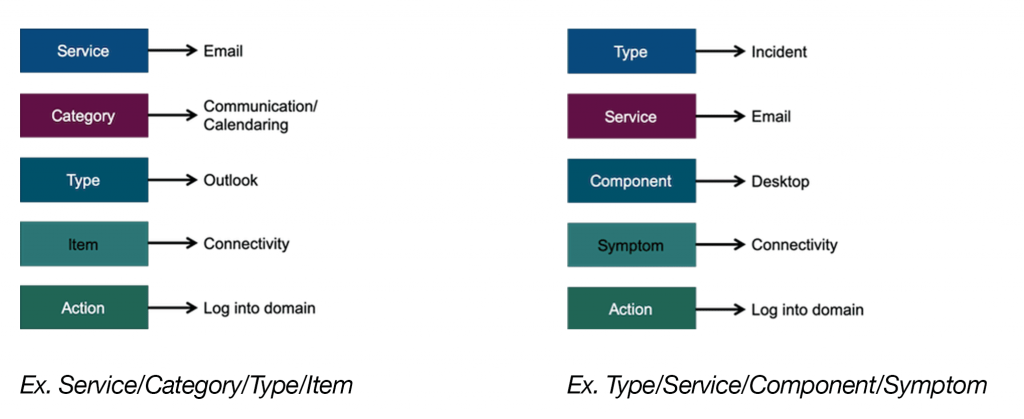
A carefully designed categorization scheme will simplify how incidents are entered into the system, reduce errors in mis-categorization, and tie each unique category/type/item to a specific owner.
Hierarchy/Dependencies Required
An important factor in reducing errors is the use of a hierarchy. The choice in the first menu provides a subset of choices in the second menu. By using a hierarchy, users have a limited number of choices instead of trying to choose from all options. The following graphic shows the difference between using a hierarchical structure and not using one:
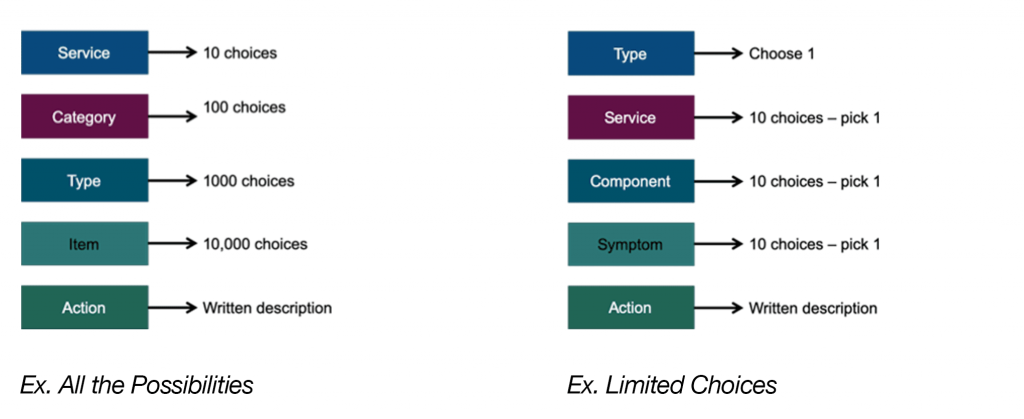
Categorization Dependencies
In the overall service value system, there are other aspects of value delivery that are tied to the categorization. The service catalog provides a view of the services that are in the operational environment. The ability to put services into categories that make sense to our customers makes it easier for customers to find information about those services and how to request them. The categorization of incidents is directly related to the ability to categorize our services. All too often, organizations try to categorize incidents before they understand how to categorize services. Even worse, if you decide to categorize incidents without understanding services, then the categorization is likely to be technology-focused and cannot provide a view of the impacted service. This will limit proactive service management.
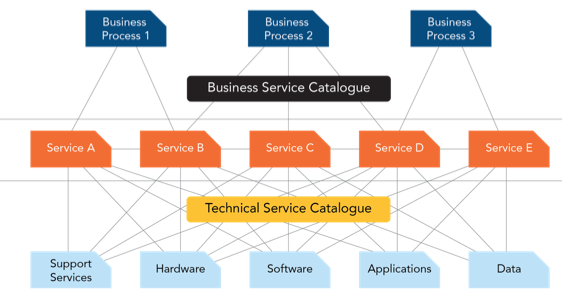
Service Catalog Dependencies tied to Categorization
Incident management drives process improvement through the analysis of incidents to identify improvement opportunities. By using accurately categorized incident data, the overall customer experience can be analyzed to determine what is working well and where improvements can be made for the customers.
Career development also depends upon categorization. For each service in the service catalog, the organization needs to have a full understanding of the skills and level of experience required to support the offered products and services. When a new service is added to the service catalog – it is then entered in the incident categorization – and training and skills development requirements should then be identified. Additionally, management can use the identified skills and experience requirements to develop training and career development plans for analysts.
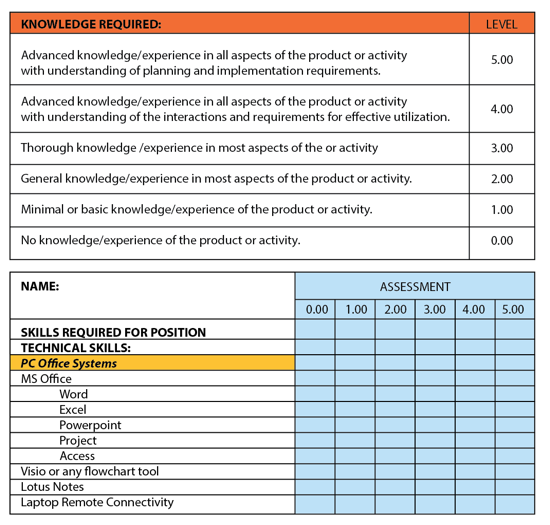
Skill Assessment and Depth of Knowledge tied to Categorization
Categorization is also critical to establishing expectations when the organization develops operational-level agreements. What is solved at the Service Desk before it is escalated to level 2? The organization needs a core understanding of the types of incidents related to services, the level of support provided at the service desk, and what support is provided by level 2 and beyond.
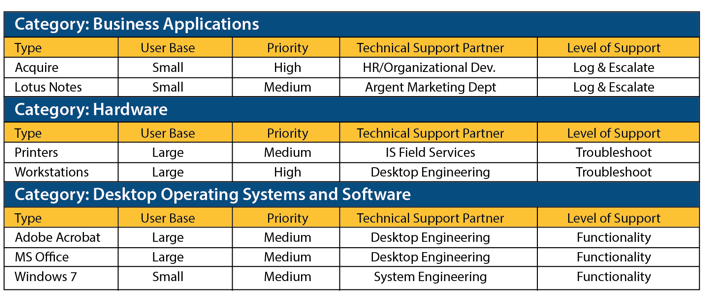
Priority, Escalation Path’s and Level of Support tied to Categorization
Event management also has a direct dependency on incident categorization. The ability to build automation that supports filtering events and correlation of incidents to determine the appropriate control action is vital to the success of the process.
Proactive problem management is nearly impossible to do without useful categorization. Imagine trying to run a report that provides visibility into all incidents and problems related to a specific service, type of issue, or component if the analyst can log a single incident in five or six different categorizations. There will be no ability to conduct trend analysis.
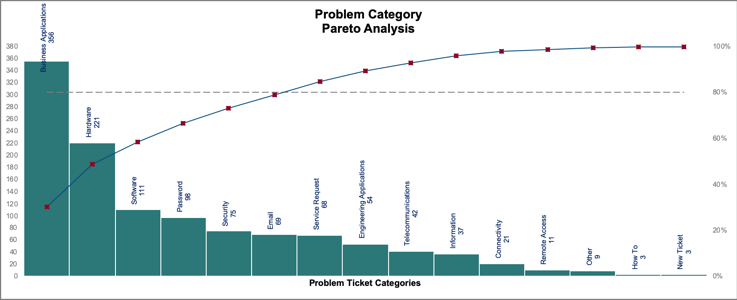
Trend Analysis Requires Accurate Categorization
A report may find some similarities between incidents and problems, but without the full picture, we may not. Service improvement and error elimination opportunities are much easier to identify with a working categorization that is used in both the problem and incident management processes.
Overall, the information captured within the ITSM system represents the knowledge needed across the service value stream to understand what and how to improve service delivery.
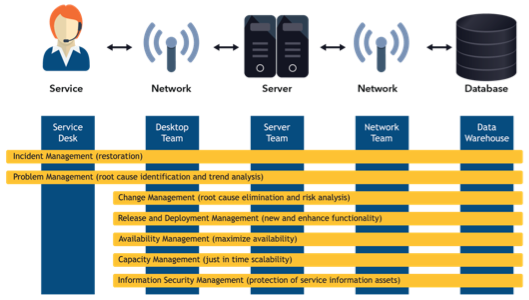
Knowledge Categorized Across Service Value Stream
It is no wonder why an accurate and usable categorization is challenging to do, with so many dependencies and requirements, how do we create a categorization scheme that works?
7-Step Categorization Process
At the core, categorization is like a set of buckets. Each bucket holds a bunch of incidents, and within the bucket; these incidents would then be logically groups by a subset of characteristics within the bucket. The first decision that needs to be made is, “What is the highest level of the hierarchy?” Here is the 7-step process to help your organization to develop a categorization scheme that works:
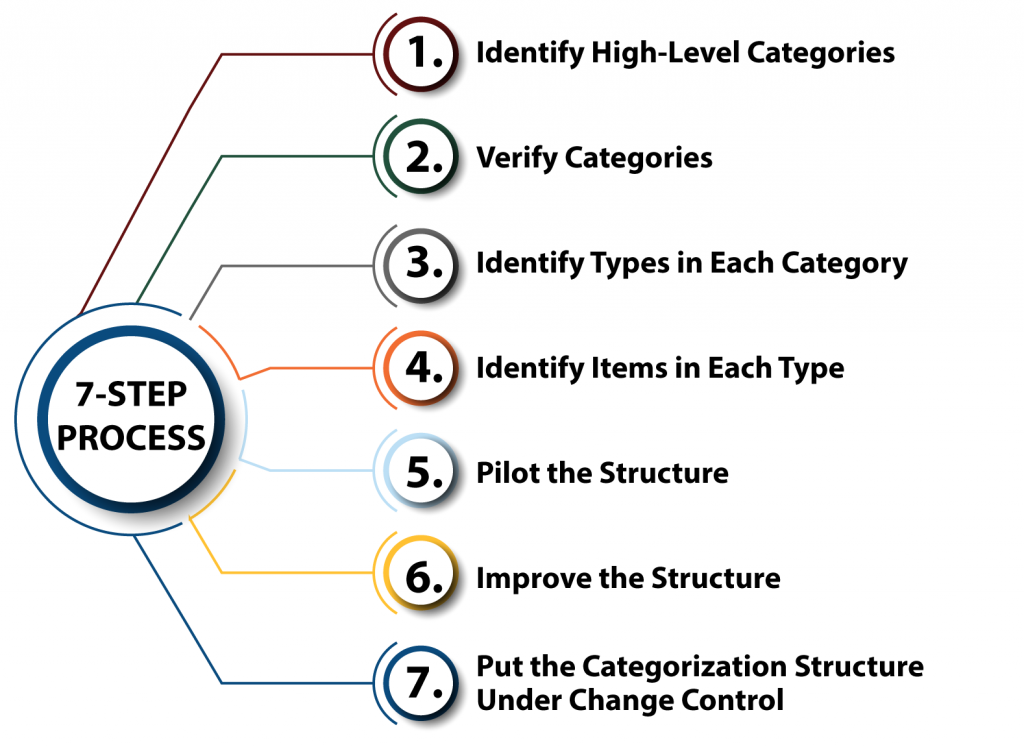
7-Step Categorization Process
Step One – Identify High-Level Categories
Incidents can be categorized by call, by type, by caller, by technology, by incident, or by service. The first decision is which of these is most important to the customer? Typically, organizations that are implementing service management will take the approach of starting with the service. Service-based categorization provides a substantial amount of value to understanding service performance and helps to identify improvements to services. This upper-level classification will not work with all organizations. External service providers may decide to choose a customer at the highest level. The key is to keep the upper or primary level general but not too broad. Ten to fifteen high-level choices should keep the level of detail at the correct level.
To develop an accurate high-level categorization:
- Pull three months of most recent activity
- Define ten high-level categories
- In a working group, sort available data in high-level categories
- Any tickets that do not fit? Revise the high-level categories
- Use “other” category temporarily to represent other possible choices not yet identified
Goal – Develop 10-15, high-level working categories
Step Two – Verify Categories
How do you get a consensus on the high-level choices? Review the structure after 3-6 months of use:
- Reassemble project team
- Verify that the identified categories work
- If “other” category used, sort and determine how to categorize
- If the structure does not work, modify as needed
Goal – Standardize on 10-12 categories
Step Three – Identify Types in Each Category
Next, the secondary level must be decided. This step is completed by looking at the incidents in each high-level category and further determine how to divide those tickets up effectively within the categorization. The second level should be specific but should not dive into the minutiae:
- Once you have a category filled with 3-6 months of data, the next step is to sort and analyze the common types = in the category
- In this step, you are creating collections of common types that are in the category
- In a working session, divide the tickets into common types
Goal – Develop 10-15 types per category from step 2
Step Four – Identify Items in Each Type
The third level provides much higher visibilities into the specifics of what is occurring in the incident. The level of detail here has to be driven by organizational need and the type of incidents that are captured:
- Once you have the types identified, the next step is to analyze what items are in each type
- In a working session, divide up the tickets into common items
- Create collections of common items that are in each type
Goal – Develop 10-15 items per type identified in step 3.
Step Five – Pilot the Structure
The next step is to establish a temporary structure that will be used and tested in the live environment. At this point the structure is temporary to allow for modification based upon actual calls that are received. Each call that does not fit into the structure should be reviewed to determine if a change is needed to the structure. To not slow down the flow and handling of incidents, an “other” category is often used. All analysts are encouraged to put incidents into the other category when the structure doesn’t handle the type of incident reported. The other categories are then analyzed on a weekly or bi-weekly basis to determine additional CTI structures that must be added. Long-term use of the other structure should be avoided.
- Now that you have ten high-level categories and ten types per category it is time to try it in the live environment
- Pilot the structure
- Again, use “other” to capture those new items that either do not fit or are new
Goal – Gather information on how the structure works
Step Six – Improve the Structure
After the pilot is complete, it is crucial to now go back and review the “other” categories and determine if the categorization structure works for all incidents identified in the pilot and after. Once the “other” category is reviewed, it should probably be removed from the structure as an option. It is imperative not to change the categorization structure too often after the pilot as the organization will lose the historical perspective of the data.
Goal – Improve as needed to meet the evolving needs of the business
Step 7 – Put the Categorization Structure Under Change Control
Once the team finalizes the categorization structure, it should now be placed under change control. Any new categorizations that are identified should only be added after an RFC is submitted, and the risk of changing the structure is adequately assessed. However, some circumstances will commonly require adjustments to the categorization:
- When new services are introduced – the category structure should be updated to match
- When services are retired – the category structure should be updated by archiving the appropriate data
- When services are changed – must identify if modifications are necessary
Goal – Require the organization to agree on changes to minimize risk.
Pitfalls to Avoid
Too Many or Too Few
There are many ditches to avoid categorization. If the categorization has CTI structures with too many tickets or too few, this is an indication that the categorization scheme is not effective. The exact number is hard to determine but is more easily expressed in percentages. If you have a CTI structure that holds 25% of your ticket volume, then the structure may not have enough detail. If a CTI structure contains less than 2%, then it probably is too specific.
Avoid Constant Re-Categorization
Every change to the categorization will change the way existing data is structured and will impact historical analysis. Changes to the categorization must be carefully planned for the risk that it can introduce. It should not, however, discourage change. Organizations are not stagnant, and neither should the categorization scheme be frozen in time.
Do Not Categorize by Symptoms
It is also essential to focus on capturing information that is factual and not symptom-based. A specific IT incident can have many different symptoms. To categorize by symptoms would very quickly permit multiple categorizations for one type of incident and will immediately produce unreliable data.
Critical Success Factors
What Reports Are Needed?
Reporting from the incident management system is essential for overall quality improvement of services, processes, technologies, people, and the overall customer experience. All service management processes use this data to support decision-making. It is important to keep this in mind when data is structured, captured, and used in reports that are provided to these processes. All existing processes that are defined and managed will need this data as an input, and their needs must be taken into account. The collected data should drive improvements that are meaningful to the business and IT.
Decide first what data you need out of the incident management system. If you can get an agreement on what needs to be in reports on the incident management process and services, then it will help the organization to define the outcome of the categorization activity. Service level agreements are instrumental in identifying what we should measure in the environment. The categorization ensures that those measurements are possible.
Maintain a Customer or Business Focus
The tendency for an IT organization is to focus the CTI structure on the internal view of IT. An internal-only view will serve the purpose of identifying improvements in components but won’t serve the need to drive improvements in services. The data collection must be business-driven, not IT-driven. The external view will provide data collection that will support better decision-making and analysis based upon what is important to the business.
Be Sure to Train
Training is essential to the correct categorization of incidents. Even the best-defined categorization scheme is subject to error. Organizations that are trained on how to categorize with the ticketing system and know how to handle exceptions will have higher quality data. The redundancy of categorization must be avoided through design and operation.
Use Closure Categories
Changes to the categorization of an incident throughout the incident management process should be avoided. If a customer calls in and reports an incident and the categorization is determined but later to is determined to be incorrect, the best way to handle this is to create a closure categorization. Closure categorization provides the organization with a way to improve the process and improve the training of analysts recording the incidents. Also, some incidents will present symptoms that indicate a particular structure, but it is uncovered through diagnosis that the issue turns out to be something very different. Both categorizations can be helpful to find the solution the next time the issue occurs.
Put Structure Under Change Control
Once the environment has stabilized, the categorization should be under change control to ensure that any changes will keep the underlying data in its highest level of accuracy.
Summary
The benefits of a good categorization scheme are many. The categorization will ease the process of logging incidents, reduce redundancy, and strengthen the organization’s ability to manage knowledge and use it to support decision making. The underlying data will enable the organization to take a proactive view of service management and identify improvement opportunities. The view will be across functional silos not based upon the technology that is managed. A well-designed categorization will provide a better overall view of the services and how they are meeting customer expectations and service level targets.
Someone once said that nothing in life worth doing is easy, and it is especially true with categorization. Creating a useable and sustainable categorization is a tough exercise that will pay off in the end. The data collected in the incident management process represents every touchpoint, every aspect of the customer experience. If we capture that knowledge in a way that it can be reused to support continual improvement, the organization will improve services, improve customer satisfaction, and improve efficiency and effectiveness of the operation. That is definitely something worth doing.

